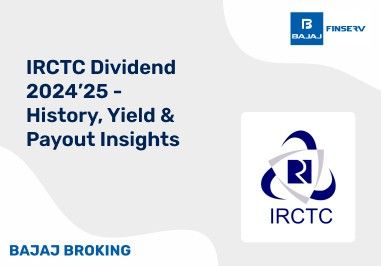BAJAJ BROKING
Ather Energy IPO is Open!
Open a Free Demat Account
Trade Now, Pay Later with up to 4x
Track Market Movers Instantly
What are the Mutual Fund Fees, Charges and Expenses in India
Introductory Description
Explore the essential guide to mutual fund fees and charges in India. Understand the various costs associated with investments, including expense ratios and transaction fees, to maximise your returns and make informed financial decisions for your future.
Features
Transparent Pricing
Cost Analysis
Investment Strategies
Fee Comparison
Fees and Charges for Investing in Mutual Funds in India
When investing in mutual funds in India, understanding the various mutual fund fees and mutual fund charges is crucial for maximising returns. These fees can significantly impact your overall investment performance, making it essential to evaluate them before committing your capital. Common mutual fund fees in India include the expense ratio, transaction charges and exit loads. By being aware of these costs, investors can make informed decisions that align with their financial goals, ensuring a more profitable investment journey.
Overview of Mutual Fund Fees in India
Understanding mutual fund fees is essential for investors looking to optimise their returns in a complex financial landscape. In India, mutual fund investments are subject to various mutual fund charges, which can significantly influence overall profitability. The key fees include the expense ratio, transaction charges and exit loads, each playing a role in the total cost of investing. Investors should carefully evaluate these charges as they can erode potential gains over time. Regulatory bodies like SEBI have implemented guidelines to ensure transparency in mutual fund fees in India, making it easier for investors to comprehend what they are paying for. By staying informed, investors can make better choices that align with their financial objectives. Opening a demat account with Bajaj Broking can facilitate a smooth investment journey, providing the tools and resources necessary to navigate mutual fund investments effectively while keeping an eye on costs.
What Are the Different Types of Mutual Fund Fees?
When investing in mutual funds, it’s vital to be aware of the various mutual fund fees that may apply. The primary charges include:
Entry Load
An entry load was previously a fee charged at the time of investment. However, since SEBI abolished this fee in 2009, investors no longer bear this cost. This significant regulatory change has promoted a more transparent investment environment, encouraging more individuals to invest in mutual funds without the concern of incurring immediate costs when entering the market.
Exit Load
The exit load is a fee applied when investors redeem their mutual fund units before a specified holding period. This fee is designed to discourage premature withdrawals and thus help Asset Management Companies (AMCs) manage costs associated with early redemptions. Understanding exit loads is crucial for investors who plan to adjust their portfolios frequently or withdraw funds early.
Expense Ratio
The expense ratio encompasses the annual fees associated with managing the mutual fund. It includes management fees, administrative costs and other operational expenses incurred by the fund. A higher expense ratio can significantly diminish your overall returns, making it essential for investors to evaluate this charge when choosing a fund to optimise their investment outcomes over time.
Transaction Charges
Transaction charges apply when buying or selling mutual fund units that exceed a certain threshold. In India, this threshold is set at ₹10,000. For transactions above this amount, new investors may incur a charge. These mutual fund charges can affect the overall investment cost and should be considered when planning purchases or sales to ensure cost-effective investment strategies.
How Entry and Exit Loads Affect Your Investment?
Entry and exit loads can significantly impact the overall profitability of mutual fund investments. Although entry loads have been abolished, the exit load remains relevant for investors who may need to redeem their units before the stipulated holding period. High exit loads can deter investors from making necessary adjustments to their portfolios, leading to potential losses if market conditions change unfavourably. Investors should consider these mutual fund fees when planning their investment strategy, as frequent buying and selling may not be beneficial due to these additional mutual fund charges. A well-considered investment horizon is essential to avoid incurring unnecessary costs. Understanding these fees can guide investors in selecting the right mutual fund that aligns with their financial goals while minimising costs, especially considering the landscape of mutual fund fees in India. To get started, interested investors can open a demat account to manage their investments efficiently.
Understanding the Expense Ratio in Mutual Funds
The expense ratio is a crucial aspect of mutual fund fees, encompassing various costs incurred in managing a fund. It consists of several components, including:
Components of Expense Ratio
The expense ratio comprises several components, including management fees, administrative costs, distribution fees and other operational expenses. By breaking down these elements, investors can assess the fund's cost structure effectively. Knowing these components helps investors compare different funds and choose those with lower mutual fund charges, which can enhance potential returns over the investment horizon, contributing to better financial outcomes.
How Expense Ratio Impacts Returns?
A high expense ratio can significantly reduce overall returns, as it directly affects the net profits realised by the investor. For instance, an expense ratio of 2% means less capital is working for the investor, impacting growth potential. Lower expense ratios are generally preferable, allowing for better capital growth over time and maximising the investor's wealth accumulation in the long run.
Transaction Charges for Mutual Fund Investments in India
Transaction charges are another important aspect of mutual fund fees in India. These fees are levied when an investor buys or sells units worth more than ₹10,000. For new investors, the maximum transaction charge is capped at ₹150, while existing investors face a limit of ₹100. These charges can accumulate, impacting overall investment performance. As such, it's advisable for investors to plan their transactions judiciously, ensuring that they remain within the threshold to minimise additional costs. By being mindful of transaction charges, investors can enhance their returns and make more informed decisions. Opening a demat account with Bajaj Broking can facilitate efficient management of these transactions, helping investors stay ahead.
What is the Maximum Limit of Expense Ratio in Mutual Funds India?
The Securities and Exchange Board of India (SEBI) has stipulated maximum limits for mutual fund expense ratios, which vary based on assets under management (AUM). These limits ensure that investors are not overcharged and can maximise their returns.
Assets Under Management (AUM) | Debt Mutual Fund Expense Ratio Limits | Equity Mutual Fund Expense Ratio Limits |
Up to ₹500 crore | 2.00% | 2.25% |
On the next ₹250 crore | 1.75% | 2.00% |
On the next ₹1,250 crore | 1.50% | 1.75% |
On the next ₹3,000 crore | 1.35% | 1.60% |
On the next ₹5,000 crore | 1.25% | 1.50% |
On the next ₹40,000 crore | 0.05% reduction for every ₹5,000 crore increase | 0.05% reduction for every ₹5,000 crore increase |
Exceeding ₹50,000 crore | 0.80% | 1.05% |
The flexibility afforded to AMCs allows them to adjust their expense ratios while adhering to SEBI's caps, helping ensure fair pricing for investors. Understanding these limits can guide investors in selecting funds that align with their financial goals while keeping costs manageable.
Comparing Fees for Different Types of Mutual Funds
Different types of mutual funds have varied fee structures that can affect investor returns. Here’s a breakdown of fees associated with different fund categories:
Equity Funds
Equity funds typically have higher expense ratios due to the active management required. Fund managers actively select stocks to capitalise on market opportunities, leading to elevated fees. The potential for higher returns justifies these costs, making it essential for investors to weigh the expense against the expected gains before making investment decisions.
Debt Funds
Debt funds generally have lower expense ratios compared to equity funds. This is because they are often passively managed, focusing on fixed-income securities with less active oversight. As a result, these funds tend to be a more cost-effective choice for conservative investors seeking stable returns without incurring high fees. Understanding these costs is vital for effective investment planning.
Hybrid Funds
Hybrid funds, which invest in both equity and debt, typically feature moderate expense ratios. This dual investment strategy allows for diversification benefits, appealing to investors looking for a balanced risk-return profile. By combining different asset classes, hybrid funds aim to optimise returns while managing costs effectively, making them suitable for investors seeking flexibility and stability in their portfolios.
Are There Any Hidden Charges in Mutual Fund Investments?
While mutual fund charges are generally transparent, investors should be aware of potential hidden costs that may not be immediately evident. These could include fees related to fund switching, additional transaction charges and any fees associated with financial advisers or distributors. Such costs can accumulate and significantly affect overall investment returns. It’s crucial for investors to conduct thorough research and read the fine print before committing to a mutual fund. This diligence will ensure they are fully aware of all mutual fund fees and can plan their investments accordingly. Consulting with a financial adviser can also help clarify any ambiguous charges and align investment strategies with financial objectives.
How to Minimise Mutual Fund Fees and Charges?
Minimising mutual fund fees is crucial for enhancing overall investment returns. One effective way to do this is by opting for direct plans, which generally feature lower expense ratios compared to regular plans. Investors should also consider investing through platforms like Bajaj Broking, which may offer lower transaction charges and better transparency. Regularly reviewing the expense ratio and other fees associated with mutual funds can also help identify more cost-effective options. Additionally, being mindful of transaction limits can prevent incurring unnecessary charges. A well-planned investment strategy, coupled with awareness of fees, can significantly enhance net returns and ensure that investors meet their financial goals efficiently.
Why Do Regular Plans Have a Higher Expense Ratio?
Regular plans of mutual funds typically come with higher expense ratios compared to direct plans. This disparity arises due to the involvement of distributors or agents in regular plans, who receive commissions for facilitating the investment. These costs are then passed on to the investor, leading to higher overall fees. In contrast, direct plans allow investors to bypass intermediaries, resulting in lower expense ratios and, consequently, better net returns. Understanding this distinction is vital for investors aiming to maximise their investments. By opting for direct plans where possible, investors can minimise costs and enhance their portfolio's overall performance. It's essential to weigh the benefits of professional advice against the potential for higher fees when making investment decisions.
Conclusion
In conclusion, understanding mutual fund fees and charges is paramount for investors seeking to optimise their investment strategies. From the expense ratio to transaction charges and exit loads, each fee type plays a crucial role in determining the net returns. Investors should remain vigilant and conduct thorough research before selecting a fund, ensuring they consider not only the fees but also the fund’s performance, risk profile and management quality. With the right approach, including opening a demat account with Bajaj Broking, investors can navigate the mutual fund landscape effectively while minimising costs. Ultimately, making informed choices will empower investors to achieve their financial goals and build wealth over the long term.
Disclaimer: Investments in the securities market are subject to market risk, read all related documents carefully before investing.
This content is for educational purposes only. Securities quoted are exemplary and not recommendatory.
For All Disclaimers Click Here: https://bit.ly/3Tcsfuc
Share this article:
Read More Blogs
Disclaimer :
The information on this website is provided on "AS IS" basis. Bajaj Broking (BFSL) does not warrant the accuracy of the information given herein, either expressly or impliedly, for any particular purpose and expressly disclaims any warranties of merchantability or suitability for any particular purpose. While BFSL strives to ensure accuracy, it does not guarantee the completeness, reliability, or timeliness of the information. Users are advised to independently verify details and stay updated with any changes.
The information provided on this website is for general informational purposes only and is subject to change without prior notice. BFSL shall not be responsible for any consequences arising from reliance on the information provided herein and shall not be held responsible for all or any actions that may subsequently result in any loss, damage and or liability. Interest rates, fees, and charges etc., are revised from time to time, for the latest details please refer to our Pricing page.
Neither the information, nor any opinion contained in this website constitutes a solicitation or offer by BFSL or its affiliates to buy or sell any securities, futures, options or other financial instruments or provide any investment advice or service.
BFSL is acting as distributor for non-broking products/ services such as IPO, Mutual Fund, Insurance, PMS, and NPS. These are not Exchange Traded Products. For more details on risk factors, terms and conditions please read the sales brochure carefully before investing.
Investments in the securities market are subject to market risk, read all related documents carefully before investing. This content is for educational purposes only. Securities quoted are exemplary and not recommendatory.
For more disclaimer, check here : https://www.bajajbroking.in/disclaimer
Our Secure Trading Platforms
Level up your stock market experience: Download the Bajaj Broking App for effortless investing and trading













